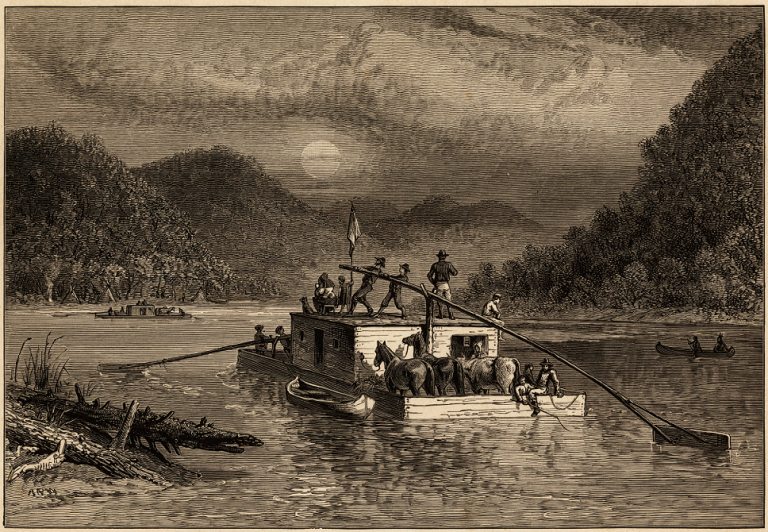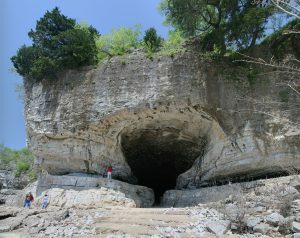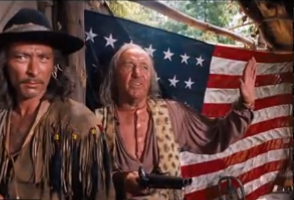Pirates of the Ohio River

Pirates of the Ohio River
by Ben Morrill, Visitor Center Site Manager
Often when you picture pirates, swashbucklers like Blackbeard and Captain Kidd, sailing the ocean plundering ships are usually what come to mind. But oceans aren’t the only place pirates can be found. As the American frontier opened up river pirates posed a serious threat to settlers moving westward down the Ohio River, lying in wait ready to relieve them of their valuable cargo.
Following the Revolutionary War, many pirates lived near sparsely populated frontier settlements, preying on settlers heading downriver in slow moving keel boats, flat boats, and rafts. Often heavily laden with goods and possessions, pirates often would conceal themselves along the river bank, ready to ambush travelers or use clever deception to get close enough to strike.

Cave-in-Rock
As traffic increased along the Ohio River, river pirates found a natural safe-haven in Cave-in Rock. Situated near the meeting point of the Ohio and Mississippi Rivers in southern Illinois, Cave-in-Rock provided pirates with shelter and natural concealment from unsuspecting settlers and law enforcement, as they pillaged and plundered unwary travelers. From 1790 to 1834, many well-known river pirates including Samuel Mason, the murderous Harpe Brothers, and the infamous Colonel Plug operated in the area.
Notorious Pirates
One of the first river pirates on the Ohio, Samuel Mason served as a captain in the Revolutionary War before moving to Henderson, Kentucky in 1790 and turning to a life of crime. Moving down river in 1797 from his previous hideout on Diamond Island, Mason became the first pirate to operate out of Cave-in-Rock. Mason and his gang regularly used deception, including posing as river guides to run flatboats aground, to prey on travelers. Mason even briefly worked with the deadly Harpe brothers before he was killed in 1803.
Spreading fear across the newly opened western frontier, Micajah “Big” Harpe and his brother Wiley “Little” Harpe terrorized settlers, killing thirty nine people while some reports put the number as high as fifty. Beginning their criminal career as part of a Loyalist group specializing in harassing Patriot families, the Harpe brothers moved west following the British defeat at Yorktown in 1781. Continuing their crime spree, the brothers spent the next several years making their way west while robbing and murdering anyone who crossed their path. In 1797 the Harpes spent a brief period with Samuel Mason, but even he and his gang were disgusted by their ruthlessness. Their misdeeds eventually caught up with them and both Harpe brothers were tracked down by posses who delivered “frontier justice.”
Putting an End to the Pirate Menace
To combat the pirate menace, flat boats began traveling in small flotillas, often with an armed keelboat as an escort to fend off potential attackers. Meanwhile, newly invented steamboats proved too fast for slow moving pirates to target. With the army and law enforcement stepping up operations against criminals, river piracy on the Ohio began declining in the early 1820s. Although some pirates like James Ford continued operating into the 1830s, piracy on the Ohio was largely eliminated by the 1840s.

River Pirates in Popular Culture
While you won’t see any pirates looking to plunder their boats on the Ohio anymore you can still find them in film and television. Walt Disney’s 1955 Davy Crockett and the River Pirates centers on the “King of the Wild Frontier” facing river pirates loosely based on Colonel Plug and Samuel Mason. Similarly, Walter Brennan character Colonel Jeb Hawkins in the 1962 film How the West Was Won is portrayed as a Samuel Mason like gang leader, a reminder of the ruthless pirates that once raided the Ohio River.

